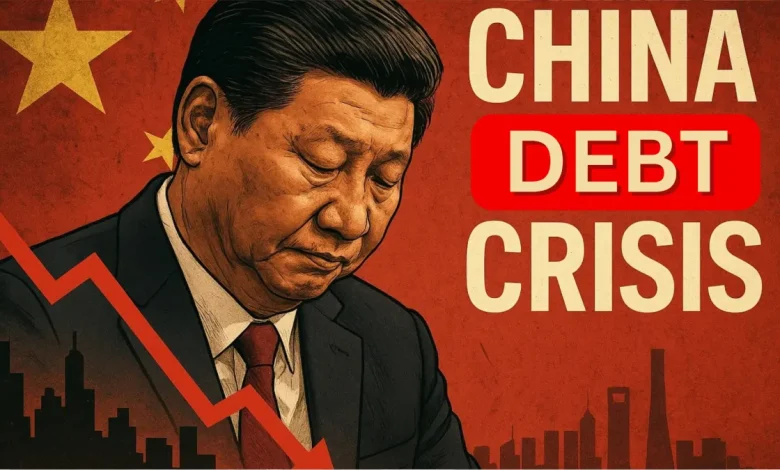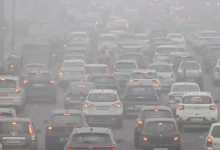Inside China’s 300% Debt Shadow: Off-Book Loans, Ghost Cities and a Property Bust Fuel a Slow-Burning Crisis — and Warnings for India

[By Our correspondent: Devansh Desai]
Debt Picture
China’s official debt burden appears manageable at under 100% of GDP, but the video contends that off-book liabilities push the real figure close to 300 % , transforming a balance-sheet problem into a system-wide debt risk. The narration underscores the paradox of dazzling infrastructure gains alongside “ghost” capacity: about 50 new urban hubs with scant residents and roughly 65 million empty homes, enough to house the population of France. It adds that some local governments have delayed or trimmed salaries, a sign of fiscal stress moving from spreadsheets into everyday life
Incentives and LGFVs
At the core is a political economy where local leaders are rewarded for outpacing national growth targets, turning GDP into a career “scorecard” that favors visible construction over measured demand. Local governments, responsible for about 85% of public spending but receiving only ~ 50 % of tax revenue, cannot legally borrow, so they turned to LGFVs off-balance-sheet financing companies that pledge state land to raise bank loans. Funds then flow into airports, highways, and business parks, boosting headline GDP and promotions even when projects are misaligned with underlying demand.
Ghost Cities and Households
This model inflated real estate far beyond use, culminating in entire districts with wide roads, transit lines, and offices but few tenants, including examples such as Ordos’s Kangbashi and Yujiapu’s “Manhattan”-style towers. By 2020, households had parked more than 70% of their wealth in property, a concentration that left families exposed when prices stalled and projects underperformed. The transcript stresses that construction’s momentum became circular more building lifted GDP, which encouraged yet more approvals, even where genuine demand was thin.
Evergrande Shock
The flywheel seized with the Evergrande crisis, as one of the country’s largest developers struggled under roughly USD 300 billion in liabilities, shaking confidence across the sector. Developers pulled back from land purchases, slashing local land-sale revenues by about half in many regions in 2022 and starving LGFVs of cash. As the property market cooled, prices fell, mortgages soured, and the financing loop that sustained city-building and local budgets began to unravel.
Hidden Liabilities
By late 2023, local government financing debt had climbed to an estimated 60–66 trillion yuan about USD 8–9 trillion—according to the video’s accounting of off-book obligations. The narration frames that sum as nearly half of China’s GDP and “twice India’s GDP,” a scale intended to convey both the breadth of the buildup and its policy significance. It notes that fiscal strain became concrete for civil servants in some provinces, where salary payments reportedly lagged when LGFVs could not roll or service their debts.
Beijing’s Stopgaps
To buy time, Beijing has launched a debt swap that converts hidden local obligations into official bonds with lower interest and longer maturities akin to consolidating multiple high-rate credit cards into a single, cheaper loan. The video cautions that this does not solve the underlying problem but stretches the runway for adjustment, even as about 10 trillion yuan was due across 2023–2024. Regulators have also asked major state banks to slow loan recoveries, ease interest burdens, and give borrowers more time, a bid to smooth deleveraging and avoid cliff effects.
What’s at Stake
The outcome hinges on whether authorities can align incentives, transparently reckon with liabilities, and shift investment toward projects with real cash flows rather than headline-grabbing square footage. If policy traction falters, the transcript warns of more defaults, job losses, and a broader slowdown, given real estate’s 25%- 30 % share of economic activity. If it succeeds, a gradual stabilization could follow less spectacular than past booms but more durable than growth manufactured by debt-fueled overbuilding.
Lessons for India
First, growth must track demand: building ahead of need risks stranded assets that look like GDP today but become fiscal liabilities tomorrow, especially when financed off-book. Second, transparency is a shield, not a chore hidden debt behaves like a time bomb, and the transcript’s central admonition is to make every borrowed rupee visible and trackable. Third, reward what lasts: recalibrate incentives toward jobs, productivity, and sustainability rather than short-term infrastructure tallies that tempt local leaders into misallocated sprints.




